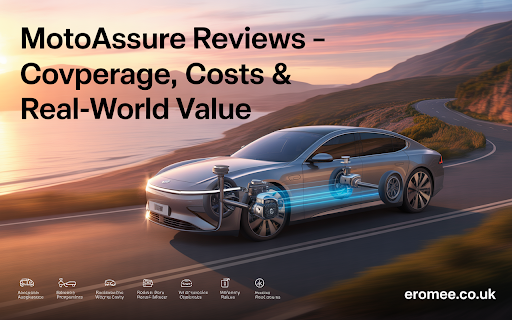Introduction
When your car’s manufacturer warranty is about to expire, the idea of facing a $3,000 transmission repair or a $1,500 air conditioning failure can be daunting. Extended vehicle protection plans are designed to reduce that financial risk, but the level of service can vary dramatically between providers. Lately, MotoAssure reviews have been attracting attention from drivers looking for dependable coverage against costly repairs. Is MotoAssure truly a value-driven choice or just another warranty contract filled with fine print? This comprehensive review explores coverage options, customer experiences, costs, and practical advice for making the right decision.
What Is MotoAssure?
MotoAssure is a U.S.-based provider of extended vehicle service contracts—often referred to as extended warranties in everyday conversation. These contracts cover specific repair and replacement expenses after the original manufacturer’s warranty expires, offering drivers financial protection against mechanical breakdowns.
Unlike dealership warranties, which are usually included with a new car purchase, MotoAssure sells stand-alone plans that can be customized to match a vehicle’s age, mileage, and the owner’s budget. This flexibility allows customers to choose from different tiers, ranging from full coverage to more basic, budget-friendly protection.
Coverage Options in Detail

The most comprehensive tier, Platinum Coverage, includes repairs for major mechanical systems such as the engine, transmission, and drivetrain, along with electrical components, air conditioning, heating, and certain safety systems. Depending on the contract terms, it can also include coverage for some wear-and-tear items, making it best suited for newer vehicles or owners who want maximum protection with minimal out-of-pocket costs.
The Gold Coverage tier offers balanced protection for drivers seeking solid coverage without paying for every high-end feature. It typically includes major mechanical systems, some electrical components, and basic A/C and heating repairs. While it excludes certain advanced electronics, it still protects against the most common and costly repairs.
For those seeking the most affordable option, Powertrain Coverage focuses on essentials—primarily the engine, transmission assembly, and drive axle. This is often a good match for older or high-mileage vehicles where the greatest risk lies in catastrophic failures rather than smaller repair needs.
Some contracts also include optional maintenance packages covering oil changes, tire rotations, and inspections. These add-ons help maintain vehicle performance and may assist in keeping coverage valid.
PedroVazPaulo Coaching
Learn more about coaching strategies and professional growth.
Why Many Drivers Choose MotoAssure
One of the strongest selling points, often noted in MotoAssure reviews, is protection against escalating repair costs. Over the past decade, vehicle repairs have become increasingly expensive, especially with the rise of complex electronics and advanced safety systems. For many, converting unpredictable repair expenses into fixed monthly or annual payments offers peace of mind.
Flexibility is another advantage. The ability to tailor coverage means customers can avoid paying for services they don’t need while ensuring their most critical systems are protected. Additionally, MotoAssure contracts are generally honored at thousands of licensed repair facilities nationwide, giving drivers the freedom to choose where their vehicle is serviced. Many plans also include perks like roadside assistance, towing, and rental car reimbursement—extras that prove valuable during emergencies.
Insights from MotoAssure Reviews
Positive feedback often mentions fast claim approvals, clear explanations of deductibles, and professional communication from customer service representatives. Many drivers credit their MotoAssure plan with saving them thousands of dollars in unexpected repairs, particularly those who travel long distances or drive older vehicles.
On the other hand, some negative MotoAssure reviews stem from misunderstandings about coverage limits. A common issue arises when buyers assume “bumper-to-bumper” protection without carefully reviewing exclusions. Others have noted cancellation fees for ending a contract early or expressed frustration over high-pressure sales tactics from certain representatives. These concerns highlight the importance of reading the full contract and asking questions before signing.
Case Studies from Real Customers
Maria, a teacher from Ohio, purchased a Platinum plan for her 2018 SUV. Two years later, her transmission failed, resulting in a $6,200 repair bill. Thanks to her MotoAssure coverage, she paid only a $100 deductible, saving more than $6,000 and avoiding significant financial strain.
Jake, a high-mileage driver in Texas, chose the Powertrain plan for his 2015 pickup, which he drives about 25,000 miles each year. Within 14 months, his drive axle needed replacement—an $1,800 job. His plan covered the repair entirely, preventing a major hit to his budget.
Who Should Consider MotoAssure?
Not every driver needs an extended warranty, but MotoAssure can be particularly beneficial for those whose factory coverage has expired, anyone who drives long distances regularly, or owners planning to keep their vehicle for many years. It is also a sensible option for people concerned about the financial impact of major mechanical failures.
MotoAssure Reviews — TechBullion
Tips Before Buying
Before committing, read the contract thoroughly to understand inclusions and exclusions. Match the coverage level to your vehicle’s actual needs—there’s no sense in paying for high-tech electronics coverage if your car doesn’t have them. Compare deductible amounts, as a higher deductible lowers premiums but increases out-of-pocket costs per claim. It’s also important to check if there are per-incident or lifetime payout limits, and to review cancellation and refund policies in case your circumstances change.
Balancing the Pros and Cons
MotoAssure offers multiple coverage levels, a wide repair network, and extra benefits such as roadside assistance, all of which are reflected positively in many MotoAssure reviews. The main drawbacks include the fact that not all repairs are covered, potential cancellation fees, and the reality that extended coverage may not be cost-effective for newer cars still under manufacturer warranty.
The Bottom Line on MotoAssure Reviews
For many customers, MotoAssure delivers solid value by offering financial protection against expensive repairs, flexible plan options, and nationwide support. The most satisfied customers tend to be those who carefully match their coverage to their vehicle and take time to fully understand the contract before signing. While no extended service plan can completely eliminate repair expenses, MotoAssure’s blend of coverage, customer service, and added benefits makes it a strong contender in the extended warranty market.
FAQs
Is MotoAssure worth it for newer cars?
If your vehicle still has years of factory coverage left, you may not need it immediately. However, locking in a plan early can sometimes secure a lower rate for future protection.
How long do MotoAssure plans last?
Plan length varies, but most last between two and seven years, or up to a set mileage limit—whichever comes first.
Does MotoAssure cover pre-existing issues?
No. Like most service contracts, pre-existing problems or known defects before purchase are excluded from coverage.
Can I use my own mechanic?
Yes, as long as they are a licensed repair facility that meets the plan’s requirements.
What if I sell my car?
Many MotoAssure plans are transferable to the new owner, which can increase the resale value of your vehicle.

